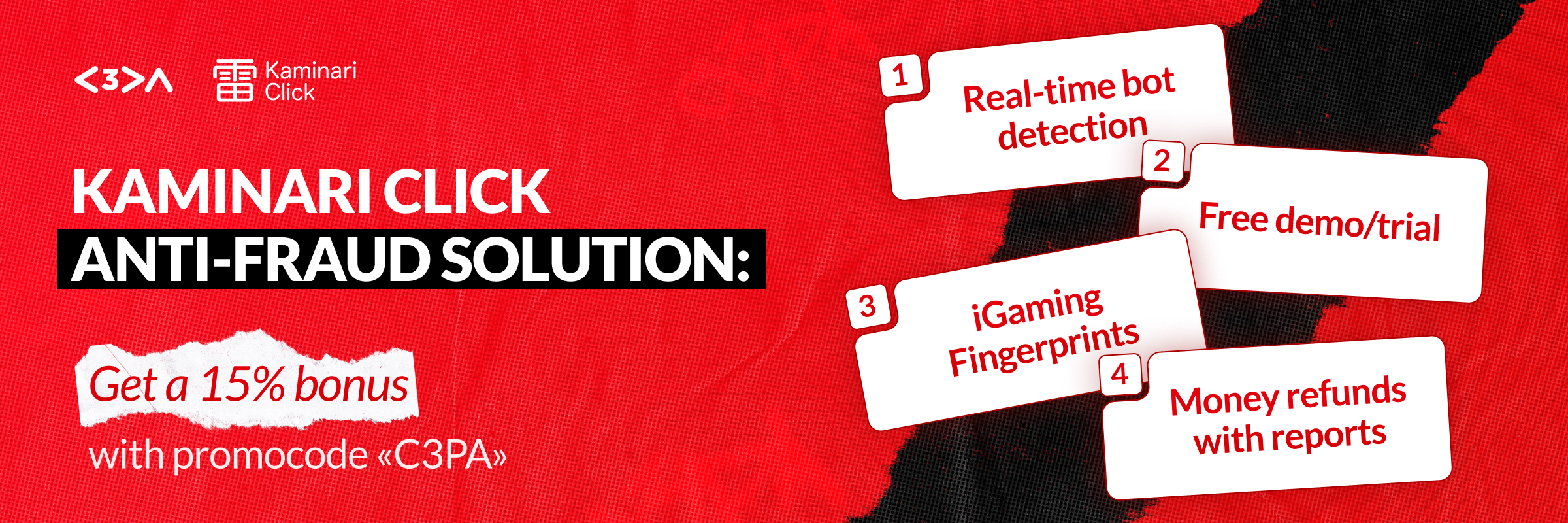How Affiliate Networks Fight Fraud: The Role of Anti-Fraud Services
Online advertising fraud continues to evolve rapidly, and without effective solutions, companies risk losing not only their budgets but also the trust of their partners.
In this article, we will discuss why it is essential to use anti-fraud solutions to maintain high-quality advertising traffic. We invited Alen, CEO of Kaminari Click, as an expert in the field of anti-fraud with years of experience in the affiliate industry. He and his team work daily to enhance fraud detection technologies, helping partners minimize risks and improve the efficiency of advertising campaigns.
Alen, to start, we would like to know what types of fraud schemes exist today and how they are evolving.
✅ Advertising traffic fraud is constantly evolving, adapting to new protection technologies, so there are countless fraud schemes. However, four main types of fraud are commonly identified: crawlers, spoofing, automated fraud, incorrect requests, bad reputation IPs, and blocked hints.
Fraud is growing, and in 2025, it will continue to expand. Fraudsters are already using machine learning, advanced browser emulators, and VPNs to make their bots appear like real users.
What are the most common fraud schemes? Can you share real case studies and insights?
✅ One example of combating fraud is our work with the CPA network Offergate. We identified a high percentage of bot traffic that negatively impacted advertising campaigns.
We tackled the fraud issue as follows:
- Analyzed behavioral factors in real-time.
- Filtered out suspicious IP addresses and unnatural click patterns.
- Implemented intelligent algorithms to determine the likelihood of fraud at the pre-bid level.
As a result:
- We reduced the percentage of fraudulent traffic by 37%, increasing advertisers' ROI by 25%.
- Detected and blocked 85% of fraudulent registrations.
- Reduced costs on useless impressions and clicks.
What are the main challenges affiliate networks face?
✅ Through customer development interviews, we identified key problems for affiliate networks:
- High levels of fraud reduce trust, lower ROI, and require reliable protection.
- A significant portion of the budget is wasted due to fraud.
- Fraud forces advertisers to implement KPIs and hold periods, reducing CPA rates and ultimately decreasing network revenues.
If you are looking for a reliable affiliate network with clean traffic, C3PA is an excellent choice. Here, you can find high-quality traffic free from fraud that truly converts. The network enjoys a high level of trust among advertisers as it actively fights fraud and maintains its reputation. If transparency, stability, and results matter to you, C3PA is a great partner for collaboration.
How does bot traffic impact company profits?
✅ Bots are not just a budget drain; they negatively impact analytics, conversions, and reputation. Money is wasted, real users never reach the product, and advertising platforms may even block an account. As a result, instead of business growth, companies face losses.
Why is it important to determine traffic quality and segment it?
✅ Not all traffic is equally valuable. High-quality traffic brings leads and conversions, whereas mixed traffic without proper filtering may include bots and low-paying audiences. Segmentation helps filter out low-quality traffic, improve ROI, and build transparent relationships with partners. For affiliate networks, this is also a reputation-enhancing tool: proper distribution of traffic streams among advertisers helps them achieve better results while networks strengthen trust and long-term partnerships with advertisers.
What key fraud and anti-fraud trends should we expect in 2025?
✅ Fraud is becoming smarter and more sophisticated. New fraudulent schemes emerge every year, and the key is to adapt to changes and develop new detection methods. If we talk about major fraud trends in 2025, we can highlight:
- AI Bots – Fraudsters disguise bots as real users, making detection more difficult.
- Deepfake Advertising – Fake creatives and user data.
- Automated Fraud Networks – Neural networks assist in bypassing security measures.
- Native Fraud – Fraudsters use "clean" IPs and proxies.
- Strict Regulatory Control – New laws make data analysis more complex.
How is artificial intelligence changing the game in fraud detection? How do AI and ML help detect fraud today?
✅ Previously, filters were used, but now AI learns on its own:
- ML analyzes behavior and detects unnatural patterns.
- AI identifies anomalies – from excessively perfect conversions to suspicious schemes.
- Rapid adaptation – AI adjusts to new fraud methods.
In 2025, without a powerful AI-driven anti-fraud solution, affiliate networks will find it increasingly difficult to combat fraud.
What figures and facts about web fraud can you share? How big is the fraud problem?
✅ Statistically, affiliate networks lose 20-30% of their budget annually due to fraud alone. In 2024, we conducted billions of traffic checks and helped our clients protect their advertising budgets while improving traffic quality.
Which verticals are most susceptible to fraud and bot traffic?
✅ Fraud levels depend on the vertical being targeted. If we talk about gambling and dating, these are among the most attractive verticals for fraudsters since they are highly popular and well-paid in affiliate marketing.
The same applies to crypto; affiliates with experience in gambling or dating can succeed in the crypto vertical, but it also carries high fraud risks.
What is your main advice for ad networks in the fight against fraud?
✅ Act proactively – fraud is becoming more sophisticated, and budget losses are increasing.
To minimize risks, use anti-fraud solutions – pre-bid filtering reduces losses and increases ROI. Analyze traffic, work with trusted partners, and adapt – fraudsters evolve, and protection must stay ahead of them.
